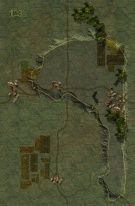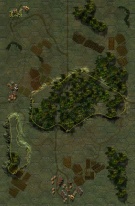|
Your Generals are Gone Road to Dunkirk #30 |
||
|---|---|---|
| (Attacker) Germany | vs |
Britain
(Defender)
France (Defender) |
| Formations Involved |
|---|

| Total | |
|---|---|
| Side 1 | 1 |
| Draw | 0 |
| Side 2 | 0 |
| Overall Rating, 1 vote |
|---|
|
4
|
| Scenario Rank: --- of 913 |
| Parent Game | Road to Dunkirk |
|---|---|
| Historicity | Historical |
| Date | 1940-05-27 |
| Start Time | 14:00 |
| Turn Count | 26 |
| Visibility | Day |
| Counters | 111 |
| Net Morale | 0 |
| Net Initiative | 2 |
| Maps | 2: 123, 124 |
| Layout Dimensions | 56 x 43 cm 22 x 17 in |
| Play Bounty | 176 |
| AAR Bounty | 227 |
| Total Plays | 1 |
| Total AARs | 0 |
| Battle Types |
|---|
| Inflict Enemy Casualties |
| Urban Assault |
| Conditions |
|---|
| Entrenchments |
| Off-board Artillery |
| Smoke |
| Scenario Requirements & Playability | |
|---|---|
| Road to Dunkirk | Base Game |
| Introduction |
|---|
|
New lines held by British and French troops along the canals running south from Dunkirk created a kind of safety zone, or corridor, down which retreating Allied troops could safely march on their way to Dunkirk. The main towns and villages were transformed into strongpoints to buy a few more days for the evacuation. Cassel is a small picturesque medieval town strategically located on top of a hill which rises some 160 meters above the surrounding flat plain of French Flanders and is an important road junction south of Dunkirk. The site had been the scene of many battles, dating back to Roman times. At Cassel Brigadier Nigel Somerset was to command a group known as Somer Force, consisting of his 145th Brigade, part of 48th Division, and some additional units. German leaflets fell across the city calling for surrender, stating “Your generals are gone!” |
| Conclusion |
|---|
|
The whole town had been converted into a fortress, complete with outposts. While the Germans on both flanks were held at bay, some two dozen tanks advanced from the south. The Czech-made panzers went in without infantry support and suffered grievous losses from anti-tank guns. The battle soon became a contest between British anti-tank guns and the tanks’ cannon and machine guns. British 25mm and 2-pounder anti-tank rounds ricocheted off the Pz 35(t)’s front armor until the gunners switched their aim to the tank tracks, or waited until the tanks passed and hit them from the side or rear; the 209th Battery claimed 40 tanks destroyed. Finally, at midnight 6th Panzer Division abandoned the fruitless assault and the surviving panzers withdrew. Though victorious, by the end of the day the Tommies were surrounded. The British held on at Cassel until the night of May 29. |
| AFV Rules Pertaining to this Scenario's Order of Battle |
|---|
|
| 5 Errata Items | |
|---|---|

|
All Bren carriers should have a movement value of 7. (Shad
on 2010 Dec 15)
|

|
Two British infantry have their full strengths printed on the back. They should both be "2-3" when reduced. (Shad
on 2010 Dec 15)
|

|
In 1940: Fall of France, the units show Direct Fire. All units are Indirect Fire. (rerathbun
on 2015 Jun 06)
|

|
The reduced direct fire value of the Heer HMG became 5-5 starting with Fall of France. (plloyd1010
on 2015 Jul 31)
|

|
The morale and combat modifiers of German Sergeant #1614 should be "0", not "8". (Shad
on 2010 Dec 15)
|

 RtDk029
RtDk029 
































